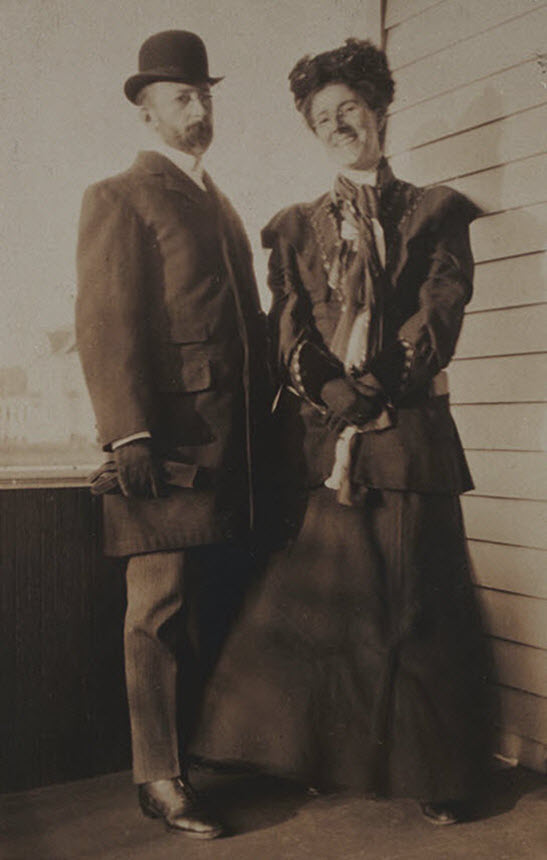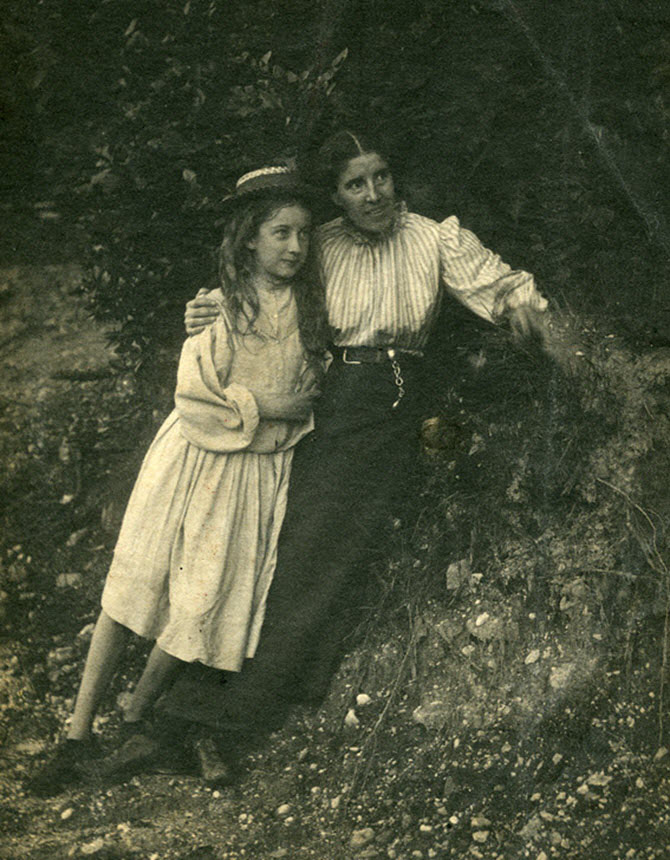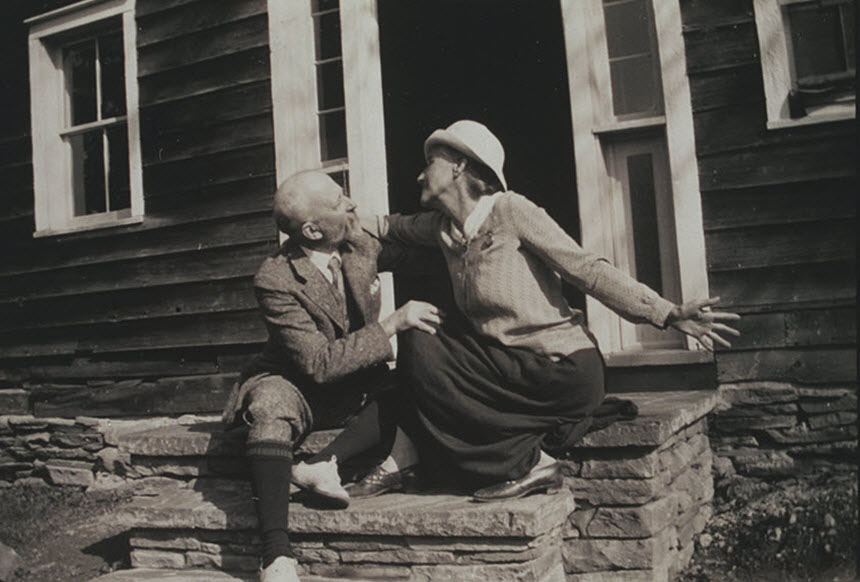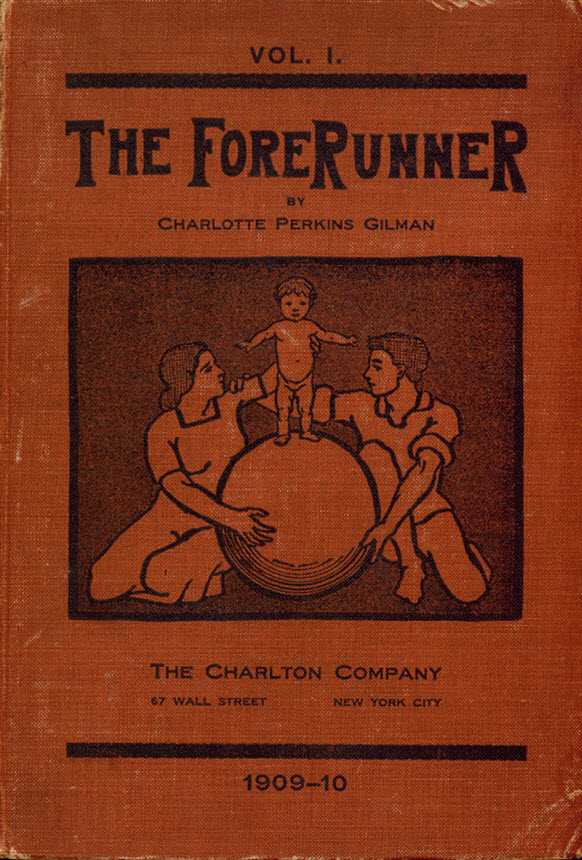While some 19th-century readers did appreciate the message hidden in “The Yellow Wall-Paper,” the story also resonated with many in the women’s movement of the 1970s. Since their rediscovery of the tale, the text has been republished many times, continuing to enthrall audiences more than a century after it was written.
Charlotte left a vast legacy of influential writings. In addition to being an important feminist thinker, she was a eugenicist, presenting her views on women and society alongside racist, xenophobic, and ableist ideas in many of her works. Her accomplishments in the sphere of women's rights overshadowed her harmful beliefs until the 21st century. Learn more about eugenics here.
Charlotte and her second husband, George Houghton Gilman, 1909
Courtesy Schlesinger Library, Radcliffe Institute, Harvard University
In the years after the publication of the “The Yellow Wallpaper,” Charlotte Perkins Gilman enjoyed great professional success and personal happiness. In 1900, she wed her cousin, George Houghton Gilman. Charlotte became a well-known writer and was regularly invited to speak on the subject of women’s rights and economic independence.
Charlotte and her daughter Katharine, ca. 1897
Courtesy Schlesinger Library, Radcliffe Institute, Harvard University
Charlotte raised Katharine for several years as a single mother. When Katharine was nine, she was sent to live with her father, so that Charlotte could focus on her career. Both women struggled with the aftermath of this decision. In later years, the two were able to rebuild their relationship.
Charlotte and her second husband playacting for the camera, ca. 1920
Courtesy Schlesinger Library, Radcliffe Institute, Harvard University
In 1932, Charlotte was diagnosed with inoperable breast cancer, and the following year her beloved husband George died suddenly from a brain hemorrhage. She moved to California to be near her daughter and grandchildren, and to work on her autobiography. When the disease progressed beyond relief, Charlotte chose to take her own life. On August 17, 1935, at the age of seventy-five, she committed suicide by inhaling chloroform.
The first issue of The Forerunner, 1909
Courtesy Library of Congress
Charlotte published The Forerunner, a monthly magazine of her work, from November 1909 to December 1916. Some pieces reflected her feminist views, as well as her advocacy for eugenics. While Charlotte’s racist, ableist thinking largely went overlooked in the latter half of the 20th century, scholars have recently brought attention to this facet of her career.
Charlotte and her second husband, George Houghton Gilman, 1909
Courtesy Schlesinger Library, Radcliffe Institute, Harvard University
In the years after the publication of the “The Yellow Wallpaper,” Charlotte Perkins Gilman enjoyed great professional success and personal happiness. In 1900, she wed her cousin, George Houghton Gilman. Charlotte became a well-known writer and was regularly invited to speak on the subject of women’s rights and economic independence.
Charlotte and her daughter Katharine, ca. 1897
Courtesy Schlesinger Library, Radcliffe Institute, Harvard University
Charlotte raised Katharine for several years as a single mother. When Katharine was nine, she was sent to live with her father, so that Charlotte could focus on her career. Both women struggled with the aftermath of this decision. In later years, the two were able to rebuild their relationship.
Charlotte and her second husband playacting for the camera, ca. 1920
Courtesy Schlesinger Library, Radcliffe Institute, Harvard University
In 1932, Charlotte was diagnosed with inoperable breast cancer, and the following year her beloved husband George died suddenly from a brain hemorrhage. She moved to California to be near her daughter and grandchildren, and to work on her autobiography. When the disease progressed beyond relief, Charlotte chose to take her own life. On August 17, 1935, at the age of seventy-five, she committed suicide by inhaling chloroform.
The first issue of The Forerunner, 1909
Courtesy Library of Congress
Charlotte published The Forerunner, a monthly magazine of her work, from November 1909 to December 1916. Some pieces reflected her feminist views, as well as her advocacy for eugenics. While Charlotte’s racist, ableist thinking largely went overlooked in the latter half of the 20th century, scholars have recently brought attention to this facet of her career.
While some 19th-century readers did appreciate the message hidden in “The Yellow Wall-Paper,” the story also resonated with many in the women’s movement of the 1970s. Since their rediscovery of the tale, the text has been republished many times, continuing to enthrall audiences more than a century after it was written.
Charlotte left a vast legacy of influential writings. In addition to being an important feminist thinker, she was a eugenicist, presenting her views on women and society alongside racist, xenophobic, and ableist ideas in many of her works. Her accomplishments in the sphere of women's rights overshadowed her harmful beliefs until the 21st century. Learn more about eugenics here.









